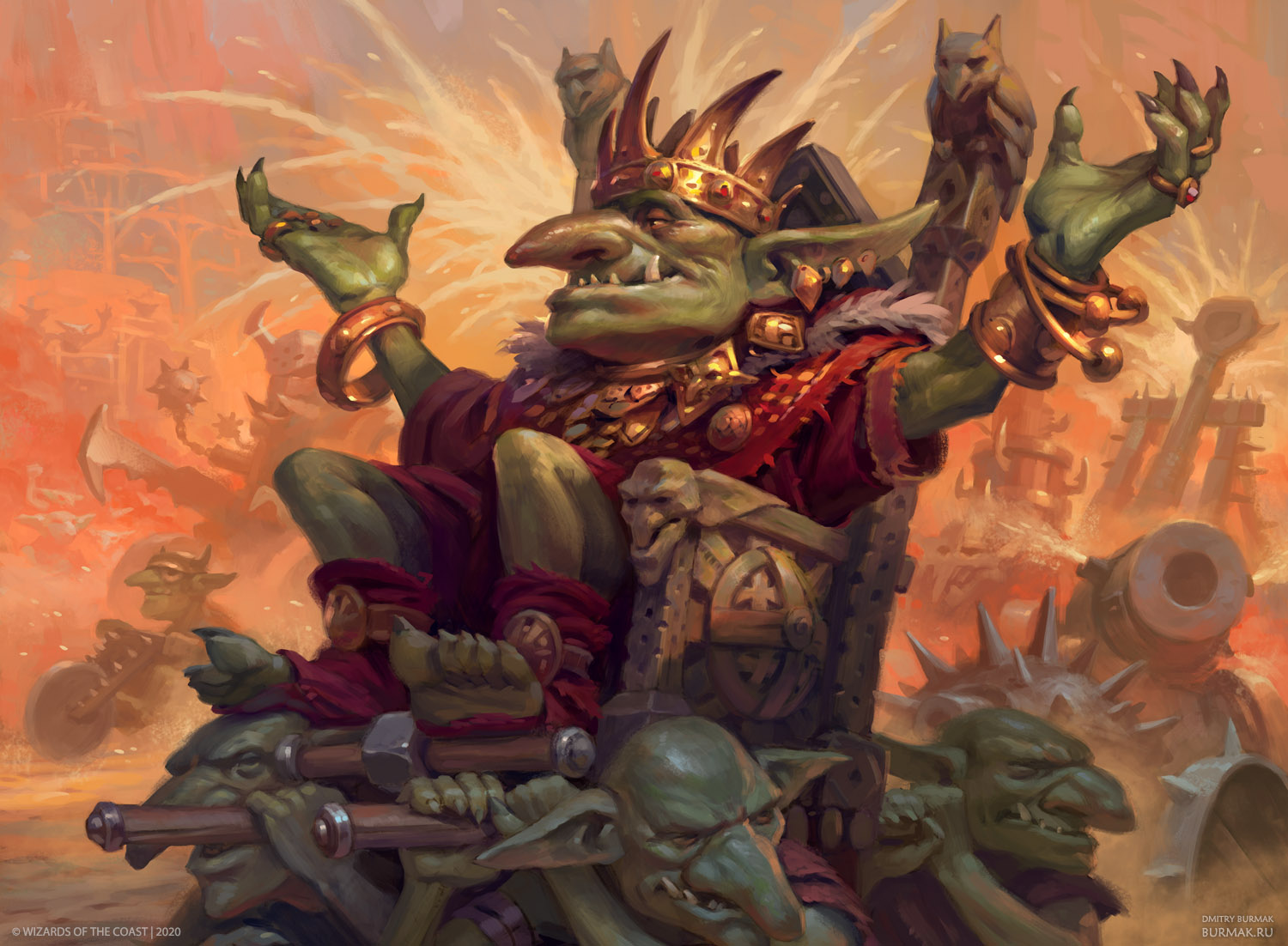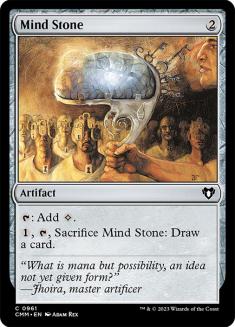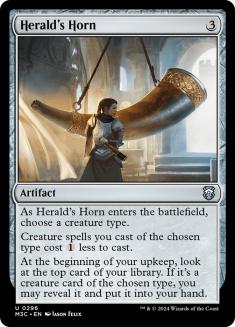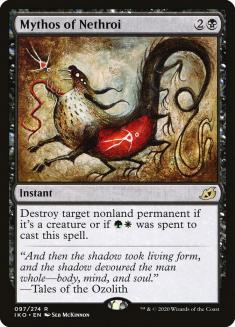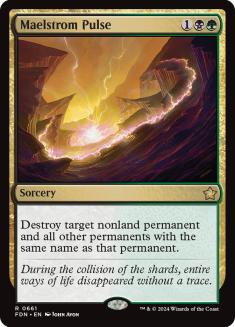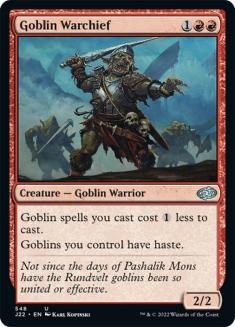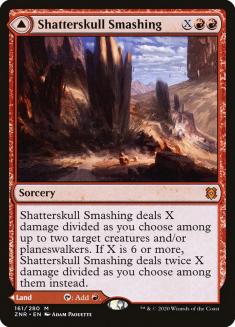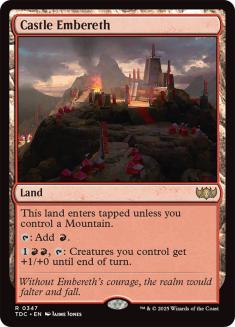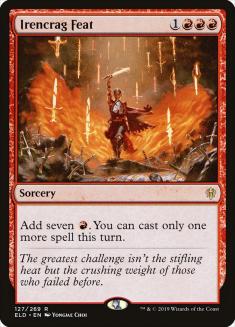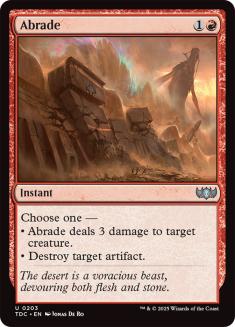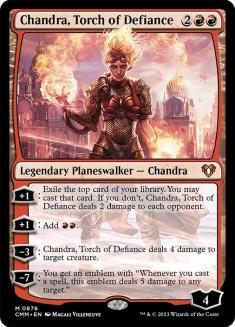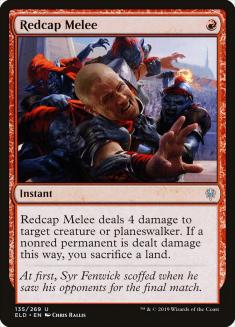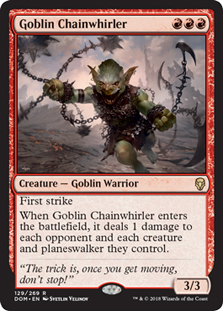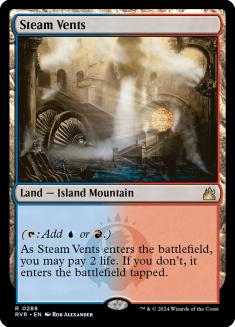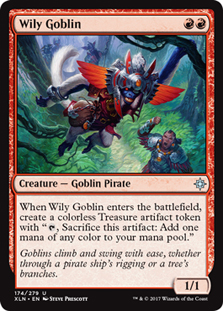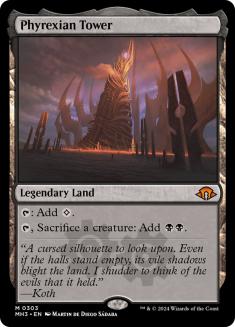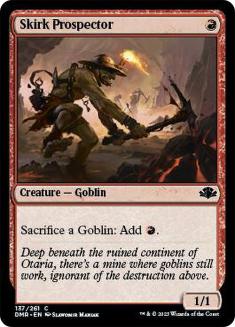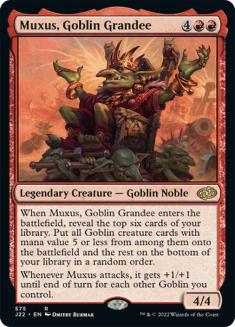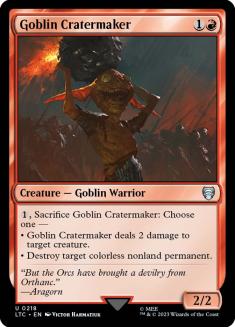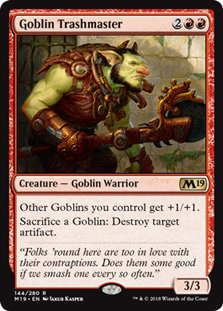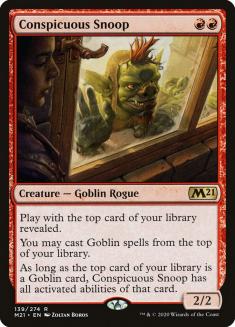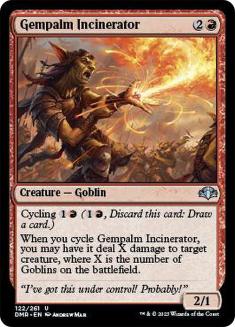This past weekend I got to the finals of the latest Pro-Tour-equivalent, the Zendikar Rising Championship, losing at the very last hurdle to Brad Barclay and so claiming second place in what I consider my second ever PT Top 8.
Whilst the Gruul Adventures list I played, tuned by my excellent teammates, was the source of a big part of my success, ultimately I played quite a few more rounds of Historic than of Standard in this tournament and so a lot of credit rests on the shoulders of my Historic deck choice, Mono-Red Goblins.
Creatures (31)
- 4 Goblin Matron
- 3 Goblin Warchief
- 4 Skirk Prospector
- 4 Goblin Chieftain
- 4 Krenko, Mob Boss
- 4 Wily Goblin
- 4 Conspicuous Snoop
- 4 Muxus, Goblin Grandee
Lands (22)
Spells (7)

Mono-Red Goblins had a pretty unexciting weekend overall in the tournament, but despite this I still made a deep run with it. Part of this is that I believe the deck is quite a bit more challenging to play than people give it credit for, part of this is that I am frankly very lucky, but on top of that I am just very happy with how my specific list is tuned compared to other Goblins lists people play and think that aided me a lot too.
These two artifacts being featured in the maindeck are by far the most noticeable thing that my list does differently to other Historic Goblins lists. The reasoning behind Mind Stone is mainly with a eye towards sideboarded games. In Game 1 it’s a fine card; it makes it more likely you’ll have a two-mana spell in your opening hand, propels you towards casting Muxus, Goblin Grandee, and has some nice synergy with Conspicuous Snoop as you can cycle Mind Stone to reset the top card of your library.
That said, where Mind Stone really shines is in Games 2 and 3. This is partially due to your deck tending to have more four-mana cards in sideboarded games, with Irencrag Feat coming in in fast matchups whilst Chandra, Torch of Defiance and Goblin Ringleader come in in slow matchups, and being able to resolve these cards on Turn 3 via Mind Stone’s boost in mana production is very appealing. The other part of the equation is that two-mana cards are the ones you tend to sideboard out the most, Conspicuous Snoop is too slow in games where you need to be linear whereas Wily Goblin is just very low-impact against slow, interactive decks, and Mind Stone allows you to sideboard down on these cards when appropriate whilst still having enough stuff to do in your opening couple turns of the game.
It’s hard to justify playing a large number of copies of the card because the deck has pretty limited use for colourless mana; if you ever have a Herald’s Horn or Goblin Warchief on the battlefield, or have drawn a Phyrexian Tower, it’s not always easy to find places to funnel this extra mana into, especially if you have multiple Mind Stones out. That said I have been quite happy with the first couple copies.
Maindecking Herald’s Horn is partially a nod towards the fact that Sultai Midrange and Four-Colour Midrange are the most successful decks in Historic and Herald’s Horn is the literal best card you can play for these Uro, Titan of Nature’s Wrath matchups specifically whilst also having a fine floor against the field at large; ultimately the card propels you towards casting Muxus, so how bad can it really be?
It’s really hard to justify not being at least partially pre-sideboarded for these Uro matchups at present, and Horn is great on multiple axes against them. The biggest one is that it’s a card that helps you grind but is near impossible for them to interact with; it gets hit by Thoughtseize and, at most, a combined total of two copies of Maelstrom Pulse and Mythos of Nethroi. Aether Gust doesn’t hit it, Nissa, Who Shake the World can’t attack it (unlike any Chandra, Torch of Defiance you control), sweepers and removal spells can’t take it off the battlefield, and it will just sit there drawing cards whilst the cost-reduction effect lets you aggressively rebuild your battlefield whenever your Goblins are swept away.
Beyond that, most of my maindeck is fairly normal. The card I trimmed to help make room for my maindeck artifacts, on top of not maindecking Goblin Matron bullets, was a single copy of Goblin Warchief as this is a card that I’d usually want to trim a copy of in sideboarded games anyways, though this is by far the deckbuilding decision that I’m least confident in due to the importance of having a haste-lord on the battlefield post-Muxus trigger.
Shatterskull Smashing has impressed me a lot, especially with Mind Stone helping you to cast it for reasonable amounts ahead of schedule; having more redundancy in answers for cards like Mayhem Devil, Krenko, Mob Boss, and Tocatli Honor Guard can just be so important and Smashing offers you this at little cost. Phyrexian Tower has been impressing me less than it used to, partially because it doesn’t make red mana in a build of the deck that naturally wants more of it than usual, so I could see a world where I end up cutting the second copy for a fourth copy of Smashing potentially.
Irencrag Feat was tech that some people brought in their Goblins lists to the Mythic Invitational a few months ago. The card never appealed to me as a maindeck card since it feels almost embarrassing against interactive decks, but it’s so powerful in matchups that are primarily about racing that I still want access to it; in the Goblins mirror getting to resolve a four-mana Muxus feels obscene. I’m surprised I’d not seen anyone just put it in the sideboard instead of maindecking it like I have, but I have been extremely happy with this and recommend it.
Abrade is just the best removal spell you can play in your Goblins sideboard, and it’s not particularly close. Not only are actual artifact decks starting to become real things, with murmurings about Paradox Engine going around, but being able to deal three damage is the perfect amount against so many problematic cards; most notably of all Mayhem Devil. As long as the Sacrifice decks are popular I would not consider registering less than four copies of this card.
As long as Uro decks are the decks-to-beat in the format, and provided they continue to look like they did last weekend, I would continue to register four copies of Herald’s Horn. That said, there are different grindy tools for different scenarios and matchups.
Chandra, Torch of Defiance is quite hard to protect against cards like Hydroid Krasis, Nissa, Who Shakes the World, and Shark Typhoon, so she actually doesn’t appeal to me hugely at present, but if people start to adopt Tocatli Honor Guard into their Uro sideboards then Chandra will become much better as having your grindy sideboard card be able to incidentally remove your opponent’s hate-card is a big selling-point.
Goblin Ringleader is at its best against decks like Azorius Control that are quite good at removing Herald’s Horn and Chandra via Cast Out or Teferi, Hero of Dominaria; in these matchups you need your grindy cards to provide you immediate value ideally and Goblin Ringleader is great at this. I hope Azorius Control doesn’t pick up in popularity too much, as the matchup is quite hard, but if it does, Ringleader is a card to keep an eye on. Previously I’ve played Legion Warboss in my sideboard too for this matchup due to how quickly it recovers you from Wrath of God, so that’s another one to keep in mind.
These cards are all notable in their absence. Redcap Melee and Magma Spray are more appealing in the mirror match than Abrade is, but not by a wide margin, and Abrade is so versatile and covers so many problems that it’s hard to justify any alternate removal spell over it. More pointedly, Magma Spray doesn’t kill Mayhem Devil and Redcap Melee is awful against Priest of the Forgotten Gods, so what are we really doing registering those cards? Graveyard hate like Leyline of the Void would be fine except I feel like any matchup where I’d bring in such a card I could happily just bring in Irencrag Feat instead and that card has much wider applicability.
Goblin Chainwhirler is a card Emma talked me off of at the last minute when she pointed out that the card isn’t actually that appealing a tutor target against any of the top decks right now. Young Pyromancer has disappeared, none of the Llanowar Elves decks are winning at present, and whilst the card is fine to tutor in the mirror match it’s much more important to have access to copies of Irencrag Feat or Gempalm Incinerator instead. It feels weird to not be playing Goblin Chainwhirler, as that card is quite powerful, but it’s just not what Historic is about at present.
Didn’t we already go through this whole thing with Thoughtseize a few months ago? One of the big draws to play Goblins is that your mana is extremely consistent, and the moment you add a second colour the deck is just going to be straight up less reliable, and for what; a few counterspells? You’re not even good at holding your mana open as your deck is all sorcery-speed spells.
Sideboard Guide
VS Sultai/Four-Colour Midrange
Out:
In:
Your impermanent mana source Goblins are much worse in slow, grindy matchups, but Skirk Prospector is specifically better than Wily Goblin here both because it’s easier to threaten to be able to cast Muxus with it and thus force your opponent to hold mana open, and because Prospector having an odd converted mana cost lines up better against Extinction Event since Krenko, Mob Boss forces Event to most often name even.
If your opponent is playing Tocatli Honor Guard, you’ll want to bring in a couple copies of Abrade to help answer this card; Abrade isn’t great in the matchup but the Honor Guards need to die and being able to kill Nissa lands can be surprisingly good when your opponent is often trying to hold open instant-speed interaction with them. If your opponent is playing Grafdigger’s Cage, which most people don’t nowadays, then bring in a copy of Goblin Trashmaster as a tutor target that’s also just a fine midrange card.
Your gameplan is to make your opponent’s interaction look as bad as possible, whilst maintaining enough of a battlefield presence that you can actually kill a Nissa should your opponent tap low for one. When I feel ahead, with card advantage flowing and pressure being developed, I very rarely jam Muxus into open mana; conversely the further behind you are the more likely you’ll just want to put Muxus onto the stack and cross your fingers. There’s a preemptive element to this too where sometimes you start jamming Muxus a turn or two before you feel like your opponent will close the door, hoping that you’ll wear through your opponent’s Aether Gusts, keep redrawing Muxus, and resolve it at the last moment.
You can Goblin Matron for more Goblin Matrons if your opponent isn’t doing anything threatening and you just want to gently build up a battlefield presence, which is a particularly appealing line when Horn is reducing the cost of these Matrons. Prioritise getting Herald’s Horn down early to stop it being hit by Thoughtseize, and remember that Herald’s Horn makes Aether Gust look really embarrassing at times as the Horn will let you grab a Gusted goblin off the top for free next turn.
VS Azorius Control
Out:
In:
Brad Barclay’s build of Azorius Control was particularly good against my list of Goblins, with plenty of answers for an early Herald’s Horn and maindeck Grafdigger’s Cage to weaken Muxus and Conspicuous Snoop. The most notable thing about how to play against this deck is that you need to have a plan for how to immediately kill Teferi, Hero of Dominaria if your opponent were to cast one next turn. With this in mind I love grabbing Goblin Chieftain with my Matron triggers, and prefer to hold my haste-lords in hand rather than expose them if possible so that they can be deployed as a follow up to the Teferi turn.
VS Mono-Red Goblins
Out:
In:
The developmental turns of the game revolve all around trying to deny your opponent’s ability to resolve a Muxus or snowball with Krenko, whilst building towards these things yourself. Always prioritise actions that benefit this approach; a lot of the time this means knowing when you’re not developing fast enough and so should answer your opponent’s haste-lords or Skirk Prospector instead in an effort to cut off threatening plays next turn.
The later turns of the game will revolve around one player trying to use advantage generated by Krenko or Muxus to end the game as quickly as possible whilst the player that is forced on the defensive tries to have a bigger Muxus turn to catch back up. Be aware that even if you’re the aggressor in this scenario, you’ll want to try and leave at least one blocker back since the body of Muxus on its own represents a lot of that card’s damage output and being able to chump-block a hasty Muxus can be the thing that stops your opponent from high-rolling a win from an otherwise losing position.
VS Azorius Auras
Out:
In:
In addition to the above, I also like to swap a single copy of Goblin Matron for a Gempalm Incinerator when I’m on the play, but I think Incinerator is too slow to matter on the draw.
Azorius Auras is one of my least favourite matchups to face; their A-Plan already lines up well against yours and they get a great sideboard against you too thanks to Hushbringer. Be willing to mulligan aggressively to find hands that have an Abrade, that provide you a clean route to a fast Muxus, or that just generally that let you come out of the gates fast.
VS Jund Sacrifice
Out:
In:
This is easily the matchup I’m least confident in my approach towards as there are a lot of cards you can have in your deck in sideboarded games that seem fine-but-not-exciting. It’s generally been my experience that you win the short-game provided you can answer Mayhem Devil, but struggle in the long-game as Jund’s engine is really good against yours once they have time to set it all up. With this in mind, it’s possible you should just be playing Irencrag Feat, even though the card is weak against Thoughtseize, so this is a possibility to keep in mind; if you want to bring in additional sideboard cards it’s easy to do so anyway as Skirk Prospector is so unappealing against Mayhem Devil that you can happily trim further on that card.
I love Mono-Red Goblins and think it’s been underrated in Historic as of late. I hope this guide serves you well and that all your Muxus triggers are game-ending!

